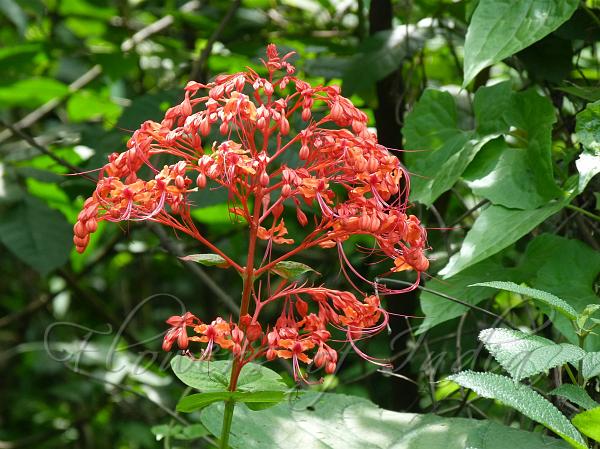|
| Japanese Glorybower |
|

|

| File size | 640211 |
| Original date | 6/23/11 11:55 AM |
| Resolution | 2560 x 1920 |
| Flash | Flash did not fire, auto |
| Focal length | 74.0mm |
| Exposure time | 1/100s |
| Aperture | 4.3 |
| Focus Distance | |
| Metering Mode | Multi-segment |
| Camera make | Panasonic |
| Camera model | DMC-FZ40 |
| Sensor type | OneChipColorArea |
|
|
|
|
Photo: |
Botanical name: Clerodendrum japonicum Family: Verbenaceae (Verbena family)
Synonyms: Volkameria japonica, Clerodendrum kaempferi, Clerodendrum squamatum
Synonyms: Volkameria japonica, Clerodendrum kaempferi, Clerodendrum squamatum
Japanese Glorybower is an erect shrub up to about 2 m high. Branches are
rather thick, bristly when young. Leaves are carried on stalks 2-10 cm
long. Leaves are circular or nearly so, 7-25 cm across, having a short
tapering tip. Leaves are deeply heart-shaped at base, very shallowly
toothed. Leaves are densely scaly beneath with rather large thick peltate
scales. Inflorescence is a large, rather open panicle, at the end of
branches or in upper axils of leaves, up to 30 cm long and wide. The
panicle is carried on stalks about 6 cm long, reddish. Flowers are
scentless, bright red, on slender stalks up to 2 cm long. Sepal cup is
bright red, cup-shaped, deeply cut into 5 thin segments, 1 cm long, scaly
and bristly. Flower-tube is 2 cm long, the 5 petals 1-1.2 cm long, red.
Stamens are 1.5 cm, protruding out. Style is up to 4 cm long.
Japanese Glorybower is found in Andaman Is., Assam, Bangladesh, Borneo,
China South-Central, China Southeast, East Himalaya, Jawa, Laos, Malaya,
Nepal, Philippines, Sumatera, Taiwan, Thailand, Tibet, Vietnam. It is found
in East Himalaya, at altitudes of 300-1600 m.
Medicinal uses: The leaves are applied to boils. A
decoction of the inflorescence is used in the treatment of gonorrhoea,
haematochezia and nosebleed.
The leaves are applied to boils. A
decoction of the inflorescence is used in the treatment of gonorrhoea,
haematochezia and nosebleed.
Medicinal uses:
 The leaves are applied to boils. A
decoction of the inflorescence is used in the treatment of gonorrhoea,
haematochezia and nosebleed.
The leaves are applied to boils. A
decoction of the inflorescence is used in the treatment of gonorrhoea,
haematochezia and nosebleed. | Identification credit: R. Vijayasankar | Photographed on Bagdogra-Gangtok highway, West Bengal. |
• Is this flower misidentified? If yes,